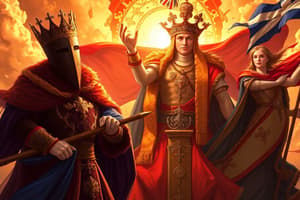Podcast
Questions and Answers
Which Scottish monarch is known for leading resistance against English rule and inspiring the film 'Braveheart'?
Which Scottish monarch is known for leading resistance against English rule and inspiring the film 'Braveheart'?
- William I (William Wallace) (correct)
- Mary, Queen of Scots
- Robert the Bruce
- James III
Which Scottish monarch secured Scottish independence from England by claiming victory in the Battle of Bannockburn?
Which Scottish monarch secured Scottish independence from England by claiming victory in the Battle of Bannockburn?
- William I (William Wallace)
- Robert the Bruce (correct)
- James III
- Mary, Queen of Scots
Which Scottish monarch's reign marked the transition from the Middle Ages to the Renaissance?
Which Scottish monarch's reign marked the transition from the Middle Ages to the Renaissance?
- William I (William Wallace)
- Mary, Queen of Scots
- James III (correct)
- Robert the Bruce
What is a key aspect of Scottish folklore?
What is a key aspect of Scottish folklore?
What is the significance of red hair in Scottish folklore?
What is the significance of red hair in Scottish folklore?
What was the role of knighthood in medieval Scotland?
What was the role of knighthood in medieval Scotland?
What is the significance of red hair in Scottish folklore?
What is the significance of red hair in Scottish folklore?
Which of the following is a famous Scottish folk story?
Which of the following is a famous Scottish folk story?
According to Scottish folklore, where do fairies inhabit?
According to Scottish folklore, where do fairies inhabit?
What was the prestigious honor of becoming a knight in Scotland reserved for?
What was the prestigious honor of becoming a knight in Scotland reserved for?
Which famous order of knights was founded in Scotland in 1687?
Which famous order of knights was founded in Scotland in 1687?
Which Scottish figure managed to maintain control and drive English influence away from the region during the Medieval period?
Which Scottish figure managed to maintain control and drive English influence away from the region during the Medieval period?
Study Notes
Scottish History and Folklore
Scottish Monarchs
Scotland's monarchy is steeped in rich history and legendary figures. From the famous tale of William Wallace to the tragic story of Mary, Queen of Scots, Scotland's monarchs have played significant roles in both Scottish and British history. Here are some notable Scottish kings and queens:
-
William I (also known as William Wallace) (1270-1305): Known as the Guardian of Scotland, he led resistance against English rule, culminating in his defeat at the Battle of Falkirk in 1298. His exploits inspired the epic poem "Braveheart," which depicted him rescuing a damsel in distress from an English tavern.
-
Robert the Bruce (1274-1329): This monarch succeeded William Wallace and is known for claiming victory in the Battle of Bannockburn in 1314, securing Scottish independence from England. Despite his military prowess, Robert spent several years on the run following a battle loss to the English.
-
James III (1451-1488): This king's reign marked Scotland's transition from the Middle Ages to the Renaissance. He encouraged education, patronized artists, and established universities. Despite his accomplishments, he faced rebellion due to his disputed marriage to Margaret Tudor, daughter of King Henry VII of England.
Scottish Folklore
Scottish folklore is rich with tales of mythical creatures, legendary heroes, and magical events. Some popular stories include:
-
Red Hair Folklore: Red hair holds significant symbolism in Scottish folklore, often associated with passion, fieriness, and the Devil. Superstitions surrounding redheads include believing red-haired children were conceived at the wrong time of the month during the Middle Ages.
-
The Knight of Riddles: This story features an ancient hero known as "The Knight of Riddles," who wore a white shield decorated with the Cross of St. Andrew. His adventures, battles, and trials are told in a series of folk songs and poems.
-
The Fairies: In Scottish folklore, fairies are believed to inhabit hills, woods, and waterfalls. They are said to grant wishes to humans who treat them respectfully and provide gifts at certain intervals.
Knighthood in Scotland
Becoming a knight in Scotland was a prestigious honor reserved for individuals of high birth and noble action. Knights protected the realm, defended the church, and served as judges and administrators. One of the most famous orders of knights in Scotland was the Order of the Thistle, founded in 1687 by James VII of Scotland to represent the highest chivalric order within the kingdom.
The Scottish Templars
Another famous order of knights in Scotland was the Order of the Temple, commonly referred to as the Knights Templar. They were originally a military order established in Jerusalem to protect Christian pilgrims traveling to the Holy Land. Although there is no direct evidence supporting the presence of the Knights Templar in Scotland during their original existence from 1119 to 1312, later revivals and pseudohistories suggested connections between Templarism and Freemasonry, particularly in the eighteenth century.
Medieval Scotland
Medieval Scotland was a period of intense political change and cultural development. During this time, clans and feudal lords held considerable power, though monarchs such as William Wallace and Robert the Bruce managed to maintain control and drive English influence away from the region. Many important structures and institutions, such as castles, churches, and universities, were constructed during this era.
In conclusion, Scottish history and folklore encompass a diverse range of subjects, from legendary kings and queens to supernatural beings and chivalric orders. The legacies of these figures continue to shape Scottish culture and identity today.
Studying That Suits You
Use AI to generate personalized quizzes and flashcards to suit your learning preferences.
Description
Test your knowledge on Scottish history, legendary monarchs like William Wallace and Robert the Bruce, intriguing folklore such as Red Hair Folklore and The Fairies, and the significance of knighthood in Scotland. Explore medieval Scotland, the Scottish Templars, and the rich tapestry of stories that have shaped Scottish culture.




